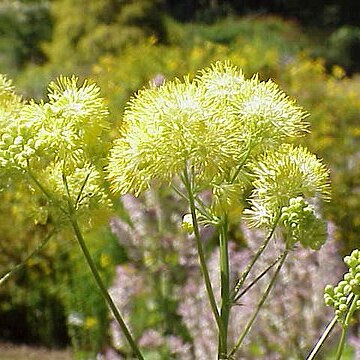Herbs , perennial, from woody rhizomes, caudices, or tuberous roots. Leaves basal and cauline, proximal leaves petiolate, distal leaves sessile; cauline leaves alternate. Leaf blade 1-4×-ternately or-pinnately compound; leaflets cordate-reniform, obovate, lanceolate, or linear, sometimes 3-lobed or more, margins entire or crenate. Inflorescences terminal, sometimes also axillary, (1-)2-200-flowered panicles, racemes, corymbs, umbels, or flowers solitary, to 41 cm; involucres absent or present, involucral bracts 2-3 (these compound, often resembling whorl of 6-9 simple bracts), leaflike, not closely subtending flowers. Flowers all bisexual, bisexual and unisexual on same plant, or all unisexual with sexes on same or different plants, radially symmetric; sepals not persistent in fruit, 4-10, whitish to greenish yellow or purplish, plane, lanceolate to reniform or spatulate, 1-18 mm; petals absent; stamens 7-30; filaments filiform to clavate or distally dilated; staminodes absent between stamens and pistils; pistils 1-16, simple; ovule 1 per pistil; style present or absent. Fruits achenes, usually aggregate, sessile or stipitate, ovoid to obovoid, falcate, or discoid, sides prominently veined or ribbed; beak present or absent, terminal, straight to coiled, 0-4 mm. x = 7.
Glabrous to pubescent erect herbaceous or lignescent perennials, occasionally stoloniferous, the roots mostly fibrous, occasionally tuberous. Leaves radical and cauline, the cauline usually alternate, decompound, glabrous to pubescent, with swollen petiolar sheaths. Inflorescences mostly terminal, paniculate or rarely racemose or subcorymbose, bracteate or ebracteate, the flowers perfect, dioecious or polygamous; sepals 4-5(-7), caducous, greenish or petaloid; petals absent; stamens numerous, free, the anthers basifixed, often apiculate; carpels few to many, inde-hiscent, uniovulate. Achenes few to numerous, more or less saccate, often costate or nerved, the elongate styles frequently deciduous.
Fls perfect or more often unisexual; plants hermaphrodite, dioecious, or polygamo-dioecious; sep 4–5, green or petaloid, soon deciduous; pet none; filaments elongate, capillary to clavate or much dilated; ovaries several, 1-seeded; style very short; stigma elongate; achenes usually conspicuously veined or ribbed, sometimes stipitate; perennial herbs with ternately decompound lvs and most ample terminal panicles of greenish, yellowish, purplish, or white fls, the color due principally to the stamens; polyploid series based on x=7. 50+, mostly N. Temp.
Flowers actinomorphic, usually rather small in terminal panicles, bisexual or some male only, sepals 3–5, imbricate in bud, green or petaloid.
Achenes sessile or stipitate, stigma deciduous or persistent forming a long beak.
Herbs with compound spirally arranged leaves with sheathing bases.
Stamens 3 to numerous, often with conspicuous anthers.
Carpels 1 to numerous, 1-ovulate.
Petals absent.

